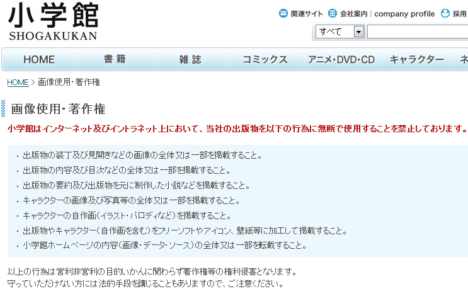Top manga publisher Shogakukan has banned almost all online fan activity pertaining to its works, most notably any form of artwork or doujinshi based on its characters.
The directives, published on their homepage and picked up on with concern by Hayate no Gotoku mangaka Kenjiro Hata:
Shogakukan forbids the following unauthorised usages of our publications on the Internet or intranets:
Posting pictures, in whole or in part, of the binding or pages of our publications.
Posting the contents or tables of contents of our publications.
Posting plot summaries or derivative stories and similar based on our publications.
Posting pictures or photographs, in whole or in part, of our characters.
Posting your own pictures (illustrations or parodies, etc.) of our characters.
Modifying our characters (including your own images) or publications for use in software, icons, wallpapers. etc.
Posting the contents of the Shogakukan homepage (pictures, data, or source) in whole or in part.
The above acts, whether commercial or non-commercial in character, are acts of copyright infringement. Those who do not respect these guidelines may find themselves subject to legal action, so please be warned.
This explicitly bans everything from fan art to wallpapers and even anime-themed avatars, and also apparently bans most Internet discussion, wiki coverage and reviews of Shogakukan works.
Just how Shogakukan expects this kind of draconian approach to suppressing its fandom to improve its position is something of a mystery, particularly given everything mentioned is traditionally considered free advertising.
The (apparently poorly understood) legal situation in most countries is that unauthorised derivative works are technically acts of copyright infringement, as copyright is held over characters and stories as well as the original work (and any translations thereof).
As a result, copyright reverts to the original copyright owner and thus distribution is subject to legal sanction at the whim of the copyright holder and the creator of the derivative work has no actual right to claim copyright of their own work (something which apparently escapes most doujin artists illegally attempting to use legal remedies such as the DMCA to control distribution of their own infringing works).
However, in many cases derivative works are explicitly permitted by rights holders on a non-commercial basis or subject to guidelines (Star Wars and Star Trek for example have elaborate rules for such creations), or else are simply tacitly ignored.
In Japan, the tradition is for the anime, manga and game industry to studiously ignore derivative works, which has allowed doujin events such as Comiket to flourish, and encouraged a multitude of artists to produce fan art depicting their favourite characters.
Many professional mangaka and artists are even active in the doujinshi field themselves, under loosely guarded pseudonyms.
Further complicating matters is the fact that in most jurisdictions copyright infringement requires some notice of objection from the copyright holder before civil or criminal action proceed – but Japanese police recently seem to have been making copyright prosecutions on their own initiative, rather than at the behest of the rights holder.
Japan also lacks a functional “fair use” doctrine for using pictures and text for commentary or reviews, or an equivalent to the DMCA’s generous allowances to sites carrying infringing content contributed by users (the DMCA grants immunity to site administrators as long as they respond to DMCA takedown requests).
All of these factors, coupled with the extreme spinelessness of most Japanese, make the Japanese Internet a rather fragile environment for the sort of activity which is taken as a matter of course elsewhere.
There is now some concern that other major publishers will follow suit with draconian copyright regimes of their own – Ishihara and the recent quake seem to have triggered an industry self-destruct mechanism…








that is so retared
This will negatively affect their future market share due to less publicity for their products….these fools.
what the f♥♥k lol.
This isn’t a lawsuit, because there is NO PROOF. I did go to Shogakukan Website and it did say they CAN sue but it doesn’t say that they ARE suing.
Whomever is responsible for this obviously hates all the anime’s Shogakukan publishes manga for, and just wants to scare us anime fanartists off sites like deviantART.
Until I see proof, this will be nothing but a HOAX.
s♥♥t. I’ve wanted to make Inuyasha doujinshi for a long while now…s♥♥t. D: But this law doesn’t quite make sense. Hell, the authors under this publication are probably like ‘What the hell.’ as well. I’m actually surprised that “Kyoukai No Rinne” isn’t on the wikipedia page of titles that Shogakukan doesn’t control. Excuse my ignorance, but didn’t the change of the spine of many spines by Viz that changed to “S” feel kind of suspicious?
And why did the Author of Hayate consult the publishing company of “concerns” that resulted in this copyright law? I feel so enraged. Something needs to happen soon. Anyways, I’m going to continue contributing fanart into the online community anyways. Are they going to sue over a million people for simply making fanart?